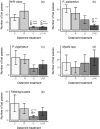Comparing acoustic and radar deterrence methods as mitigation measures to reduce human-bat impacts and conservation conflicts
- PMID: 32053663
- PMCID: PMC7018087
- DOI: 10.1371/journal.pone.0228668
Comparing acoustic and radar deterrence methods as mitigation measures to reduce human-bat impacts and conservation conflicts
Abstract
Where humans and wildlife co-exist, mitigation is often needed to alleviate potential conflicts and impacts. Deterrence methods can be used to reduce impacts of human structures or activities on wildlife, or to resolve conservation conflicts in areas where animals may be regarded as a nuisance or pose a health hazard. Here we test two methods (acoustic and radar) that have shown potential for deterring bats away from areas where they forage and/or roost. Using both infrared video and acoustic methods for counting bat passes, we show that ultrasonic speakers were effective as bat deterrents at foraging sites, but radar was not. Ultrasonic deterrents decreased overall bat activity (filmed on infrared cameras) by ~80% when deployed alone and in combination with radar. However, radar alone had no effect on bat activity when video or acoustic data were analysed using generalised linear mixed effect models. Feeding buzzes of all species were reduced by 79% and 69% in the ultrasound only treatment when compared to the control and radar treatments, but only the ultrasound treatment was significant in post-hoc tests. Species responded differently to the ultrasound treatments and we recorded a deterrent effect on both Pipistrellus pipistrellus (~40-80% reduction in activity) and P. pygmaeus (~30-60% reduction), but not on Myotis species. However, only the ultrasound and radar treatment was significant (when compared to control and radar) in post-hoc tests for P. pipistrellus. Deterrent treatment was marginally non-significant for P. pygmaeus, but the ultrasound only treatment was significant when compared to radar in post-hoc tests. We therefore suggest that acoustic, but not radar methods are explored further as deterrents for bats. The use of acoustic deterrence should always be assessed on a case-by-case basis, with a focus on bat conservation.
Conflict of interest statement
This study was part of a PhD funded by the National Environment Research Council (NERC) (NE/K007610/1). As part of the PhD funding, £3000 was provided towards stipend costs for LRVG as a CASE contribution by the commercial funder Ecotricity Group Limited (www.ecotricity.co.uk). SPCP of Ecotricity Group Limited also provided a supervisory role in the project and review of the manuscript before submission for publication. This does not alter our adherence to PLOS ONE policies on sharing data and materials.
Figures



References
-
- Nyhus PJ. Human-wildlife conflict and coexistence. Annu Rev Envrion Resour. 2016;41:143–71. 10.1146/annurev-environ-110615-085634 PubMed PMID: WOS:000398214100006. - DOI
-
- Redpath SM, Bhatia S, Young J. Tilting at wildlife: reconsidering human-wildlife conflict. Oryx. 2015;49(2):222–5. 10.1017/s0030605314000799 PubMed PMID: WOS:000352628600012. - DOI
-
- Loss SR, Will T, Marra P. Direct mortality of birds from anthropogenic causes. Annu Rev Ecol Evol Syst. 2015;46:99–120. 10.1146/annurev-ecolsys-112414-054133 PubMed PMID: WOS:000367292700005. - DOI
-
- Leopold BD, Hutchins M. Impact of wind energy on wildlife: synthesis. Human-Wildlife Interact. 2016;10(1):81–2. PubMed PMID: WOS:000376092600010.
Publication types
MeSH terms
LinkOut - more resources
Full Text Sources

